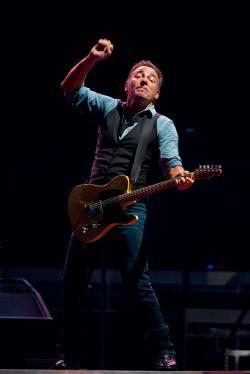The video below was created by The Timoney Group, “a consultancy specializing in geospatial analysis and information visualization.” It chronicles nearly every Springsteen performance in the United States since January 5, 1973. As time passes, red dots appear in the various locations Springsteen performed, and a halo of “heat” around it flares up, reflecting the size of the venue relative to the “overall population within 40km of the concert location. So for instance, a single arena show in New York City will generate less heat than a single arena show in Omaha, NE.”
The idea is to learn just how the popularity of Springsteen spread geographically thanks to these live shows. In his write-up of the findings, Brian Timoney concludes that there were two advantages to starting out in central New Jersey. The first of these: “From strictly a population geography standpoint, in the early 1970s you couldn’t do better than being equidistant between New York City (largest city) and Philadelphia (#4): over 20 million souls within a two-hour drive.”
The second advantage, according to Timoney, is that “the Jersey Shore provided a unique, accessible symbolic resonance to audiences that resonates as a Place.” This latter claim is certainly open to argument; Timoney links to a rather dubious New York Times column by David Brooks with the now notrious opening line: “They say you’ve never really seen a Bruce Springsteen concert until you’ve seen one in Europe.”
Still, even if you don’t agree with all of Timoney’s conclusions, this is a fun way to consider the life of a major touring act. Have a look. (Via Open Culture.)
Previously:
What Geography Can Teach Us About Basketball
How Much Does Rolling Stone Love Bruce Springsteen?
Where Do I Start With Bruce Springsteen?
